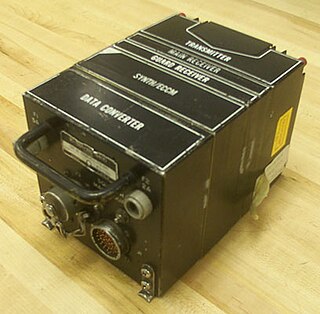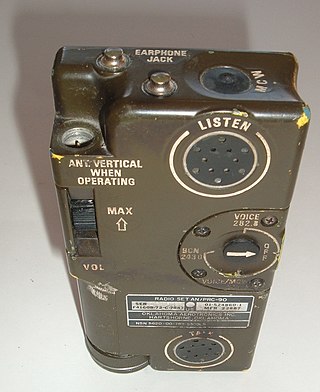
Avionics are the electronic systems used on aircraft. Avionic systems include communications, navigation, the display and management of multiple systems, and the hundreds of systems that are fitted to aircraft to perform individual functions. These can be as simple as a searchlight for a police helicopter or as complicated as the tactical system for an airborne early warning platform.

Very high frequency (VHF) is the ITU designation for the range of radio frequency electromagnetic waves from 30 to 300 megahertz (MHz), with corresponding wavelengths of ten meters to one meter. Frequencies immediately below VHF are denoted high frequency (HF), and the next higher frequencies are known as ultra high frequency (UHF).

Software-defined radio (SDR) is a radio communication system where components that conventionally have been implemented in analog hardware are instead implemented by means of software on a personal computer or embedded system. While the concept of SDR is not new, the rapidly evolving capabilities of digital electronics render practical many processes which were once only theoretically possible.

Ultra high frequency (UHF) is the ITU designation for radio frequencies in the range between 300 megahertz (MHz) and 3 gigahertz (GHz), also known as the decimetre band as the wavelengths range from one meter to one tenth of a meter. Radio waves with frequencies above the UHF band fall into the super-high frequency (SHF) or microwave frequency range. Lower frequency signals fall into the VHF or lower bands. UHF radio waves propagate mainly by line of sight; they are blocked by hills and large buildings although the transmission through building walls is strong enough for indoor reception. They are used for television broadcasting, cell phones, satellite communication including GPS, personal radio services including Wi-Fi and Bluetooth, walkie-talkies, cordless phones, satellite phones, and numerous other applications.

Single Channel Ground and Airborne Radio System (SINCGARS) is a high frequency combat-net radio (CNR) used by U.S. and allied military forces. In the CNR network, the SINCGARS’ primary role is voice transmission between surface and airborne command and control assets.

Rockwell Collins was a multinational corporation headquartered in Cedar Rapids, Iowa, providing avionics and information technology systems and services to government agencies and aircraft manufacturers. It was formed when the Collins Radio Company, facing financial difficulties, was purchased by Rockwell International in 1973. In 2001, the avionics division of Rockwell International was spun off to form the current Rockwell Collins, Inc, retaining its name.

The Joint Tactical Radio System (JTRS) aimed to replace existing radios in the American military with a single set of software-defined radios that could have new frequencies and modes (“waveforms”) added via upload, instead of requiring multiple radio types in ground vehicles, and using circuit board swaps in order to upgrade. JTRS has seen cost overruns and full program restructurings, along with cancellation of some parts of the program. JTRS is widely seen as one of the DoD's greatest acquisition failures, having spent $6B over 15 years without delivering a radio.

HAVE QUICK is an ECM-resistant frequency-hopping system used to protect military aeronautical mobile (OR) radio traffic.
In North American broadcast television frequencies, channel 1 was a former broadcast (over-the-air) television channel which was removed from service in 1948.
Aeronautical Radio, Incorporated (ARINC), established in 1929, was a major provider of transport communications and systems engineering solutions for eight industries: aviation, airports, defense, government, healthcare, networks, security, and transportation. ARINC had installed computer data networks in police cars and railroad cars and also maintains the standards for line-replaceable units.
Airband or aircraft band is the name for a group of frequencies in the VHF radio spectrum allocated to radio communication in civil aviation, sometimes also referred to as VHF, or phonetically as "Victor". Different sections of the band are used for radionavigational aids and air traffic control.
Bowman is the name of the tactical communications system used by the British Armed Forces.

In air traffic control, an area control center (ACC), also known as a center or en-route center, is a facility responsible for controlling aircraft flying in the airspace of a given flight information region (FIR) at high altitudes between airport approaches and departures. In the US, such a center is referred to as an air route traffic control center (ARTCC).

Clansman is the name of a combat net radio system (CNR) used by the British Army from 1976 to 2010.
LDMOS is a planar double-diffused MOSFET used in amplifiers, including microwave power amplifiers, RF power amplifiers and audio power amplifiers. These transistors are often fabricated on p/p+ silicon epitaxial layers. The fabrication of LDMOS devices mostly involves various ion-implantation and subsequent annealing cycles. As an example, the drift region of this power MOSFET is fabricated using up to three ion implantation sequences in order to achieve the appropriate doping profile needed to withstand high electric fields.

Survival radios are carried by pilots and search and rescue teams to facilitate rescue in an emergency. They are generally designed to transmit on international distress frequencies. Maritime systems have been standardized under the Global Maritime Distress Safety System.Civil and military organisation's utilized different frequencies to communicate and no infringement on either sector would take place. For emergencies involving civilian aircraft, the radio frequency used is VHF 121.5 MHz and for military aircraft incidents, the frequency used is UHF 243 MHz.
The ARC-231 Skyfire is a software-definable radio for military aircraft that provides two-way, multi-mode voice and data communications over a 30 to 512 MHz frequency range. It covers both line-of-sight Ultra High Frequency (UHF) and Very High Frequency (VHF) bands with AM, FM and SATCOM capabilities, including Integrated Waveform (IW). The ARC-231 radio also includes embedded anti-jam waveforms, including HAVE QUICK and SINCGARS, and other data link and secure communications features, providing battlefield interoperability. The radios utilize the MIL-STD-1553 data bus.

AN/PRC 113 Radio Set is a manpack, portable VHF and UHF AM combat radio transceiver manufactured by Magnavox America. In the Joint Electronics Type Designation System (JETDS), AN/PRC translates to "Army/Navy, Portable, Radio, Communication.
The AN/ARC-182 is a family of military aircraft radio transceivers designed for two-way, multi-mode voice communications over a 30 to 400 MHz frequency range. It covers both Ultra High Frequency (UHF) and Very High Frequency (VHF) bands with AM, FM, as appropriate. The ARC-182 radio supports the HAVE QUICK II anti-jam waveforms, with an optional control unit. It features a guard channel capability for monitoring 40.5, 121.5, 156.8 and 243 MHz. Transmitter minimum power is 10 watts, AM, and 15 watts, FM. The RT-1250A model radio can communicate with other avionics over a MIL-STD-1553 data bus.












